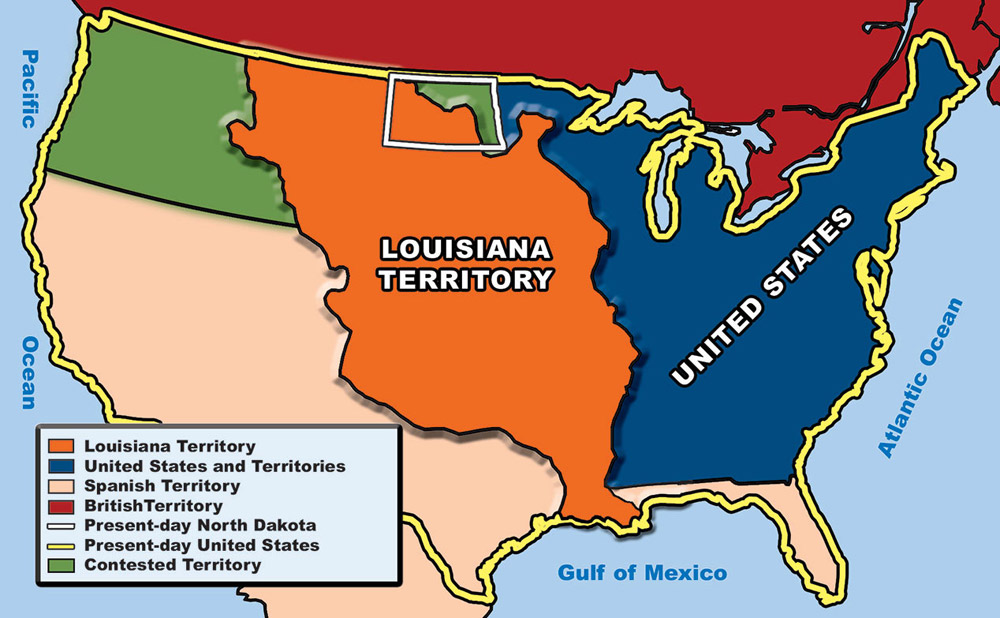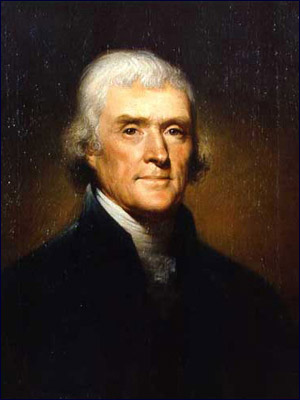In 1803, North Dakota (which, of course, was not yet North Dakota) was part of a vast French Territory called Louisiana. Louisiana, or La Louisiane as the French called it, was a quiet place with many important natural resources. (See Image 1.) Louisiana was populated by many Indian tribes, but the land was too large for France to establish effective economic or political control.

Louisiana was named by the French explorer La Salle in 1682 in honor of the French “Sun King,” Louis XIV. Originally, Louisiana included all of the Mississippi River drainage, or watershed. Every creek and river, large or small – and all the land around it – which ran into the Mississippi River or one of its tributaries, was included in Louisiana. In 1682, Louisiana included a great deal of land east and west of the Mississippi. (See Map 1.)

French citizens built two important towns in Louisiana, both on the Mississippi River. St. Louis (now in the state of Missouri) became the headquarters of the western fur trade. New Orleans was a port city where Ohio and Kentucky farmers sent their crops to market.

During the Seven Years’ War, France (with the help of Spain) fought against England and Prussia. The war was also fought in North America where it was called the French and Indian War. France lost the war in 1762 and had to give up Louisiana as a consequence. The portion of Louisiana that was east of the Mississippi River became British territory (later the United States). It was no longer Louisiana.
The western portion of Louisiana was given to Spain as a reward for helping France in the Seven Years’ War. In 1800, French leader Napoleon Bonaparte, convinced Spain to secretly transfer control of Louisiana to France. Louisiana would be, according to Napoleon, a “wall of brass forever impenetrable to . . . America.” (See Map 2.)
Spain continued to control shipping at the port of New Orleans. When Spain refused to grant Americans the privilege of using the port, the United States decided to buy the city of New Orleans. By 1802, when Congress approved a budget for the purchase, President Thomas Jefferson (See Image 2.) had become aware that France once again owned Louisiana. Jefferson sent a delegation to Paris with $10 million to negotiate the purchase of New Orleans or the right to use the port.

The negotiators were taken by surprise when France offered to sell the entirety of Louisiana for $15 million ($200 million today). Robert Livingston, leader of the delegation, did not believe that Congress would object to a larger purchase. The U.S. delegates signed the treaty on April 30 and sent it by boat to Washington, D.C. The purchase was announced to the American people on July 4, 1803.
President Jefferson was pleased. He had already warned Congress that Indian tribes in the United States were reluctant to sell any more of their treaty lands. (See Document 1.) Jefferson hinted that access to more land west of the Mississippi River would not only lead to greater trade opportunities, but might relieve some of the pressure on the expanding nation.
Document 1
January 18, 1803
Gentlemen of the Senate and of the House of Representatives:
As the continuance of the act for establishing trading houses with the Indian tribes will be under the consideration of the Legislature at its present session, I think it my duty to communicate the views which have guided me in the execution of that act, in order that you may decide on the policy of continuing it in the present or any other form, or discontinue it altogether if that shall, on the whole, seem most for the public good.
The Indian tribes residing within the limits of the United States have for a considerable time been growing more and more uneasy at the constant diminution of the territory they occupy, although effected by their own voluntary sales, and the policy has long been gaining strength with them of refusing absolutely all further sale on any conditions, insomuch that at this time it hazards their friendship and excites dangerous jealousies and perturbations in their minds to make any overture for the purchase of the smallest portions of their land. A very few tribes only are not yet obstinately in these dispositions. In order peaceably to counteract this policy of theirs and to provide an extension of territory which the rapid increase of our numbers will call for, two measures are deemed expedient. First. To encourage them to abandon hunting, to apply to the raising stock, to agriculture, and domestic manufacture, and thereby prove to themselves that less land and labor will maintain them in this better than in their former mode of living. The extensive forests necessary in the hunting life will then become useless, and they will see advantage in exchanging them for the means of improving their farms and of increasing their domestic comforts. Secondly. To multiply trading houses among them, and place within their reach those things which will contribute more to their domestic comfort than the possession of extensive but uncultivated wilds. Experience and reflection will develop to them the wisdom of exchanging what they can spare and we want for what we can spare and they want. In leading them thus to agriculture, to factures, and civilization; in bringing together their and our sentiments, and in preparing them ultimately to participate in the benefits of our Government, I trust and believe we are acting for their greatest good. At these trading houses we have pursued the principles of the act of Congress which directs that the commerce shall be carried on liberally, and requires only that the capital stock shall not be diminished. We consequently undersell private traders, foreign and domestic, drive them from the competition, and thus, with the good will of the Indians, rid ourselves of a description of men who are constantly endeavoring to excite in the Indian mind suspicions, fears, and irritations toward us. A letter now inclosed shows the effect of our competition on the operations of the traders, while the Indians, perceiving the advantage of purchasing from us, are soliciting generally our establishment of trading houses among them. In one quarter this is particularly interesting. The Legislature, reflecting on the late occurrences on the Mississippi, must be sensible how desirable it is to possess a respectable breadth of country on that river, from our southern limit to the Illinois, at least, so that we may present as firm a front on that as on our eastern border. We possess what is below the Yazoo, and can probably acquire a certain breadth from the Illinois and Wabash to the Ohio; but between the Ohio and Yazoo the country all belongs to the Chickasaws, the most friendly tribe within our limits, but the most decided against the alienation of lands. The portion of their country most important for us is exactly that which they do not inhabit. Their settlements are not on the Mississippi, but in the interior country. They have lately shown a desire to become agricultural, and this leads to the desire of buying implements and comforts. In the strengthening and gratifying of these wants I see the only prospect of planting on the Mississippi itself the means of its own safety. Duty has required me to submit these views to the judgment of the Legislature, but as their disclosure might embarrass and defeat their effect, they are committed to the special confidence of the two Houses.
While the extension of the public commerce among the Indian tribes may deprive of that source of profit such of our citizens as are engaged in it, it might be worthy the attention of Congress in their care of individual as well as of the general interest to point in another direction the enterprise of these citizens, as profitably for themselves and more usefully for the public. The river Missouri and the Indians inhabiting it are not as well known as is rendered desirable by their connection with the Mississippi, and consequently with us. It is, however, understood that the country on that river is inhabited by numerous tribes, who furnish great supplies of furs and peltry to the trade of another nation, carried on in a high latitude through an infinite number of portages and lakes shut up by ice through a long season. The commerce on that line could bear no competition with that of the Missouri, traversing a moderate climate, offering, according to the best accounts, a continued navigation from its source, and possibly with a single portage from the Western Ocean, and finding to the Atlantic a choice of channels through the Illinois or Wabash, the Lakes and Hudson, through the Ohio and Susquehanna, or Potomac or James rivers, and through the Tennessee and Savannah rivers. An intelligent officer, with ten or twelve chosen men, fit for the enterprise and willing to undertake it, taken from our posts where they may be spared without inconvenience, might explore the whole line, even to the Western Ocean, have conferences with the natives on the subject of commercial intercourse, get admission among them for our traders as others are admitted, agree on convenient deposits for an interchange of articles, and return with the information acquired in the course of two summers. Their arms and accouterments, some instruments of observation, and light and cheap presents for the Indians would be all the apparatus they could carry, and with an expectation of a soldier's portion of land on their return would constitute the whole expense. Their pay would be going on whether here or there. While other civilized nations have encountered great expense to enlarge the boundaries of knowledge by undertaking voyages of discovery, and for other literary purposes, in various parts and directions, our nation seems to owe to the same object, as well as to its own interests, to explore this the only line of easy communication across the continent, and so directly traversing our own part of it. The interests of commerce place the principal object within the constitutional powers and care of Congress, and that it should incidentally advance the geographical knowledge of our own continent can not but be an additional gratification. The nation claiming the territory, regarding this as a literary pursuit, which it is in the habit of permitting within its dominions, would not be disposed to view it with jealousy, even if the expiring state of its interests there did not render it a matter of indifference. The appropriation of $2, 500 "for the purpose of extending the external commerce of the United States," while understood and considered by the Executive as giving the legislative sanction, would cover the undertaking from notice and prevent the obstructions which interested individuals might otherwise previously prepare in its way.
TH: JEFFERSON.
The purchase of Louisiana was controversial. The Senate had to approve the treaty and the House of Representatives had to approve the expense. A bill to deny the $15 million payment failed to pass in the House by only two votes. Many critics said that the Constitution did not have a provision for the purchase of land. Some thought that Spain would be offended and might declare war on the United States. Others feared that settlers moving into the far western portions of Louisiana might not remain loyal to the United States. Another concern was that such a massive acquisition of land (828,000 square miles) would open the door for the extension of slavery.
There was also concern about what to do about the non-Indian people who already lived in Louisiana. They had been French and Spanish citizens. There were African-Americans in Louisiana who were not slaves. Would all of these people become U.S. citizens?
Some of these questions were answered with constitutional arguments; others were simply ignored. The Senate ratified the treaty of purchase on October 20, 1803 by a vote of 24 to 7.
Why is this important? The Louisiana Purchase doubled the land mass of the United States at the cost of less than three cents (40 cents today) per acre. More importantly, the addition of land was accomplished without warfare which was the most common means of expanding a nation’s land base back then.
This was a huge advance for the young nation. There was little money in the U.S. treasury; the army was small; the nation was still facing major internal structural and economic concerns. The opponents of the purchase were correct in seeing great problems in the purchase, but President Jefferson also saw great opportunities. As Robert Livingston noted when he signed the treaty, the purchase of Louisiana served to place the United States “among the [national] powers of the first rank.”
The purchase of Louisiana continued the process of enlarging the United States. By the end of the 19th century, the land west of the Mississippi had been divided into 19 states, 3 territories and more than 200 Indian reservations. Jefferson’s suggestion that Indian tribes would have to give up hunting and take up agriculture had evolved into a federal policy that led to the establishment of Indian reservations.
Before this transformation could take place, the United States had to find out what Louisiana looked like and what it could offer the nation.


